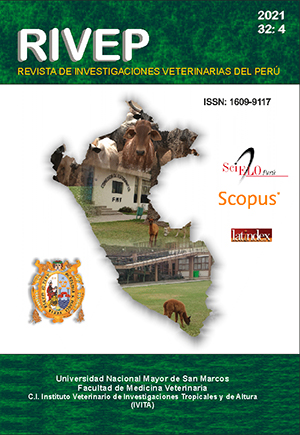Number of progeny number and accuracy of breeding value in productive traits of alpacas. A simulation study
DOI:
https://doi.org/10.15381/rivep.v32i4.19083Keywords:
estimated breeding value, accuracy, heritability, alpacaAbstract
The aim of this study was to evaluate by simulation the accuracy of the prediction of the breeding value according to the heritability of the trait and the number of progenies. Populations were simulated with six progenies for males (n = 15, 30, 50, 75, 100 and 150) and three for females (n = 1, 2 and 3) and characteristics with three heritability (h2 = 0.098, 0.22 and 0.56). The prediction of the breeding values was calculated by the method of the best unbiased linear predictor and the accuracy was calculated from the diagonal of the matrix of the mixed model equation. It was found that the higher heritability the accuracy was also higher in all scenarios. Regarding the number of progenies per male, accuracy values above 0.9 were obtained when the progeny was greater than 30. In the case of females, the highest accuracies were 0.56 for heritability with values of 0.71, 0.74 and 0.76 for 1, 2 and 3 offspring, respectively. The accuracy of the prediction of the breeding value in traits with heritability similar to those of importance in alpacas was greater when the number of progenies per male increased and when the heritability of the trait was greater.
Downloads
Downloads
Published
Issue
Section
License
Copyright (c) 2021 Gerardo C. Mamani M., Mario L. Gonzales C.

This work is licensed under a Creative Commons Attribution 4.0 International License.
AUTHORS RETAIN THEIR RIGHTS:
a. Authors retain their trade mark rights and patent, and also on any process or procedure described in the article.
b. Authors retain their right to share, copy, distribute, perform and publicly communicate their article (eg, to place their article in an institutional repository or publish it in a book), with an acknowledgment of its initial publication in the Revista de Investigaciones Veterinarias del Perú (RIVEP).
c. Authors retain theirs right to make a subsequent publication of their work, to use the article or any part thereof (eg a compilation of his papers, lecture notes, thesis, or a book), always indicating the source of publication (the originator of the work, journal, volume, number and date).










